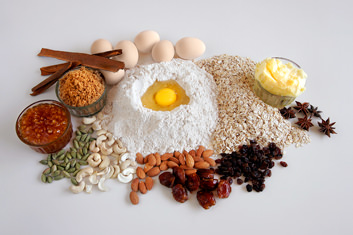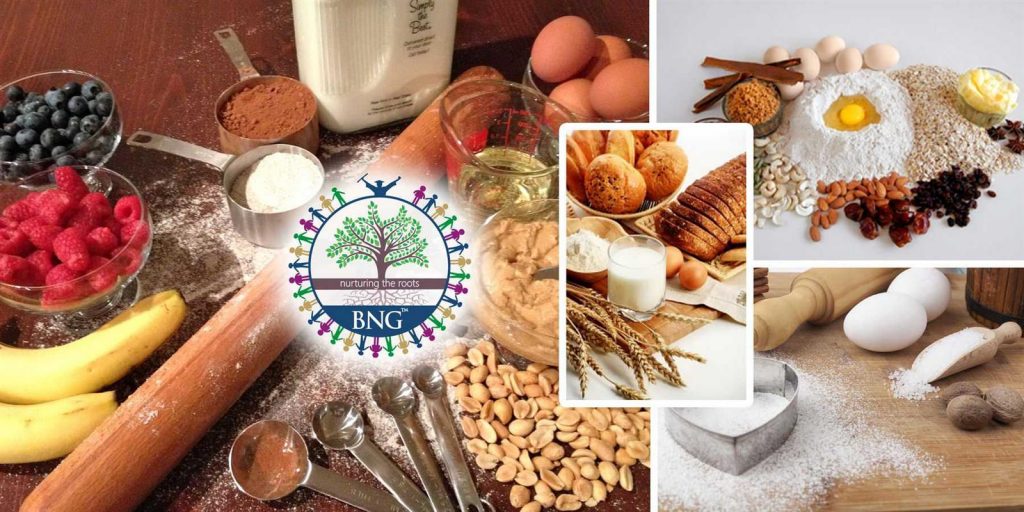Uses of bakery ingredients
Bakery ingredients used in hotels and bakeries are various types. Learn various uses of bakery ingredients, importance of bakery ingredients. Here we will discuss on top 10 Bakery ingredients used in hotels and bakeries – Flour, Butter & Margarine, Oils, Lard, Sugars, Liquids, Eggs, Salt and Leavening Agents
Flour
Gluten is a bakery ingredients substance made up of proteins present in flour. It gives structure and strength to

baked goods. For gluten to develop the proteins must first absorb water. As the dough/batter is kneaded/mixed, gluten forms long, elastic strands and as dough/batter is leavened these strands capture the gases in tiny pockets or cells and we say that the product rises. When the product is baked, like all other proteins, gluten coagulates or solidifies and gives structure to the product. The selection of flour [strong or weak], shortening used, amount of liquids and mixing methods help a baker to control gluten.
Types of Flours
- Weak Flour: Milled mainly from English & Australian wheat it is low in protein content [about 8%].
- Medium Flour: Milled from a mixture of wheat that produces flour with an average protein content [about 10%].
- Strong Flour: Milled from Canadian and American wheat, this grade is high in protein [about 17%].
- Self-Raising Flour: It is medium strength flour that has chemical agents blended with it. On being made into dough, the chemical agents react producing carbon dioxide and make the dough expand and become porous.
Brief reading on Bakery and Confectionery …here
Butter & Margarine
Butter & Margarine are bakery ingredients shortenings are manufactured to have certain textures and hardness. Butter on the other hand is a natural product that does not have these advantages. It is hard and brittle when cold and very soft at room temperature. Doughs made with butter are hard to handle, margarine is a little bit easier but has many of the same disadvantages. On the other hand butter and margarine has two major advantages, they are:
- Flavour: Shortenings are intentionally flavourless but butter has a highly desirable flavour.
- Melting Qualities: Butter melts in the mouth, shortenings do not. Pastries made with shortening leave an unpleasant film of shortening coating in the mouth.
Learn more on these ingredients .. here
Oils
Oils are liquid fats. These bakery ingredients are not often used as shortenings in baking because they spread through a batter or dough too thoroughly and shorten too much. Their usefulness is limited primarily to greasing pans, deep frying doughnuts and serving as a wash for some kinds of rolls. A few quick breads and cakes use oil as a shortening.
Lard
Lard is a bakery ingredients which is rendered fat of hogs. Because of its plastic quality, it was once highly valued for making flaky piecrust. Since the development of modern shortenings, it is not often used in the bakery.
Sugars
Sugars or sweetening agents are used as bakery ingredients for the following purposes in baking:
- To add sweetness and flavour.
- To create tenderness and fineness of texture by weakening the gluten structure.
- To give crust colour.
- To increase keeping qualities by retaining moisture.
- To act as creaming agent with fat.
Sugar is derived from sugarcane or beets. The chemical name for these sugars is “sucrose”. They can be classified as:
- Granulated/grain/table sugar: This is the most familiar and most commonly used sugar.
- Very fine/super fine/castor sugar: This is used for making cakes and cookies because they make a uniform batter and support higher quantities of fat.
- Confectioner’s/icing sugar: These sugars are ground to a fine powder and mixed with a small amount of starch to prevent caking.
- Molasses: Used as bakery ingredients which is concentrated sugarcane juice. Sulfured molasses is a by-product of sugar refining and is the product that remains after most of the sugar has been extracted from the cane juice. Unsulfured molasses is not a by-product but a specially manufactured sugar that has a less bitter taste.
- Brown sugar: This is sucrose that contains varying amounts of molasses and other impurities.
- Corn Syrup: It is liquid sweetener consisting mainly of a sugar called glucose or dextrose. It is made by converting cornstarch into simpler sugar compounds with the use of enzymes. Corn syrup aids in retaining moisture and is used in some icings and candies.
- Honey: It is a natural sugar syrup consisting largely of glucose and fructose. It is an invert sugar that means that it stays smooth and resists crystallising.
- Malt Syrup: It is used primarily in yeast bread and serves as food for yeast. It adds flavour and crust colour to the breads.
Liquids
Bakery ingredients liquids are essential for gluten formation. The amount used is critical to the type of product desired.
- Water: It is the basic liquid in baking, especially in breads.
- Milk & Cream: It contributes to texture, flavour, nutritional value, keeping quality and crust colour.
- Whole Milk contains fats that can be calculated as part of the shortening in a dough.
- Butter Milk is slightly acidic and is used for quick breads in conjunction with baking soda as a leavening agent.
- Cream is not often used as a liquid except for fillings and toppings.
- Dry Milk or Milk Powder is most often used because of its convenience and low cost.
- Eggs, Honey, Butter contribute moisture to a dough or batter.
Eggs
Eggs perform the following functions as bakery ingredients:
- Structure: Egg proteins coagulate to give structure.
- Emulsifying of Fats: Yolks contain natural emulsifiers that help produce smooth batter and contribute to volume and texture.
- Leavening: Beaten eggs incorporate air in bubbles. This air expands when heated and aids leavening.
- Shortening Action: Fat in yolks act as shortening. This is important in products that are low in other fats.
- Moisture: Whole eggs contain about 70% water. Egg white about 86% water and yolks about 49% water. This moisture must be calculated as part of the total liquid in a formula.
- Flavour
- Nutritional Values
- Colour: Yolks impart yellow colour to the doughs and batter. Eggs also brown easily and contribute to crust colour.
Leavening Agents
Leavening is the production or incorporation of gases in a baked product to increase volume and to produce shape and texture. The gases must be retained in the product until the structure is set enough to hold its shape. Exact measurement is important as slight differences can produce major defects in the final product. Example: Yeast is one of the very important bakery ingredients.
- Yeast: It is a tiny living fungus that thrives on sweetness, warmth and moisture. As the yeast eats, it excretes carbon dioxide and alcohol. This carbon dioxide causes the rise in baked products. Alcohol evaporates during baking yet helps in development of flavour in the bread. Yeast is available in two forms – Compressed (fresh) and Active dry. Active dry is a more concentrated form, so only half the weight of compressed yeast is required.
Storage 5ºC
Slow Action 15ºC to 20ºC
Best Growth 20ºC to 32ºC
Reaction Slows 38ºC
Yeast is killed 60ºC
Opening your own bakery read now: Bakery Recipes, Business, Jobs
Chemical Leaveners
- Baking Soda [soda-bicarbonate]: When moisture and acid are present, soda releases carbon dioxide that leavens the product. Acids that react are honey, molasses, butter-milk, fruits, cocoa powder and chocolates etc.
- Baking powder: It is a mixture of soda and an acid to react with. They do not depend on acid ingredients in the formula.
- Baking Ammonia: It is chemical ammonium carbonate. It decomposes during baking to release carbon dioxide and gas. Only heat and moisture is required for it to work.
- Air: It is incorporated into a batter by two methods – creaming and foaming. This air expands during baking and leavens the product.
- Creaming: Beating fat and sugar together to incorporate air.
- Foaming: Whipping or whisking eggs with or without sugar to incorporate air.
- Steam: When water turns into steam, it expands 1600 times its original volume. All baked products contain some moisture and thus steam is an important leavening agent. Puff, cream puffs, piecrusts etc. use steam as their only leavening agent.
Salt, Flavouring & Spices as bakery ingredients
Salt
- Enhances flavour
- Strengthens gluten structure and makes it more stretchable.
- Improves texture of breads.
- Inhibits yeast growth, important for controlling fermentation and prevents growth of undesirable wild yeast.





